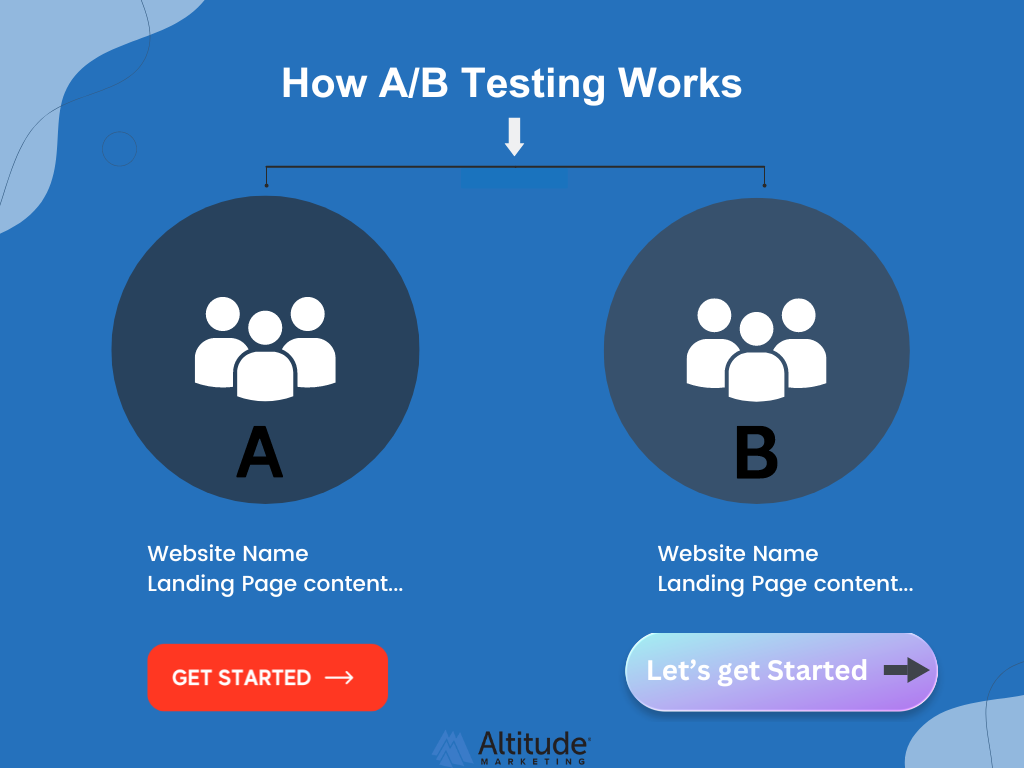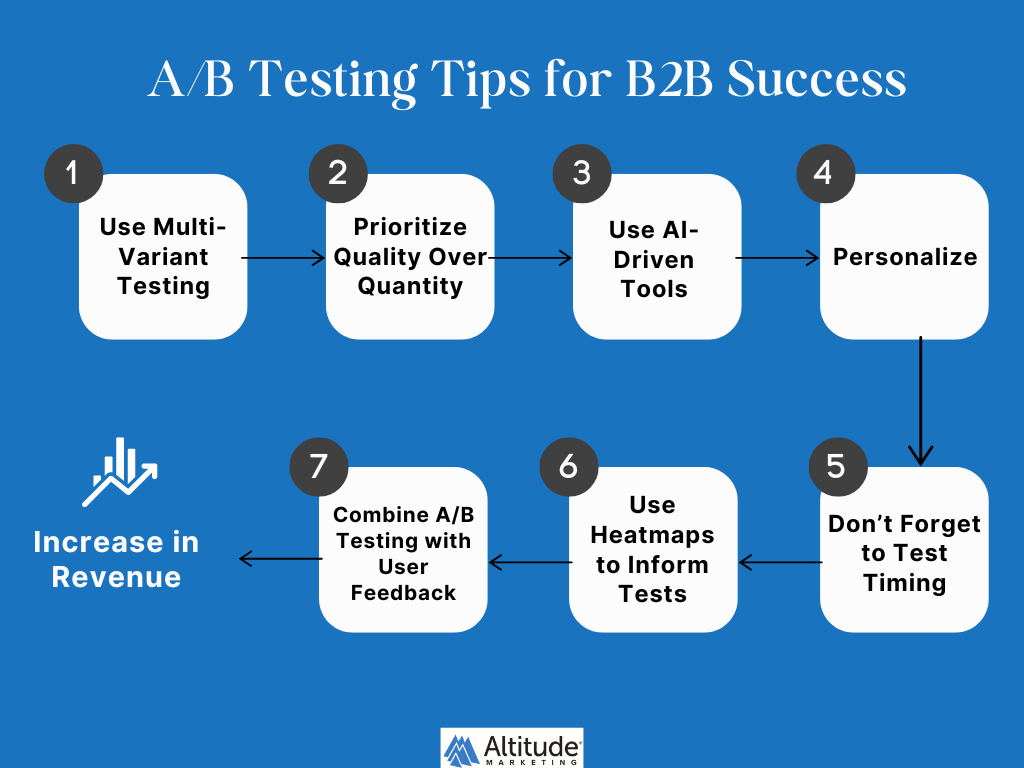Are you sure your marketing campaigns are getting the best results they can? In B2B, making informed decisions is essential, especially with longer sales cycles and multiple decision-makers involved. That’s where A/B testing plays a key role.
Companies that actively use A/B testing see an average 49% increase in conversion rates. A/B testing helps you understand what’s really working across your campaigns, rather than relying on assumptions. It’s about continuously improving, fine-tuning, and optimizing each step in the buyer’s journey. What works in B2C doesn’t always translate to B2B, where the stakes are higher, the buying process is more complex, and every lead matters.
Let’s explore how A/B testing can help you make smarter decisions and achieve better results in your B2B marketing efforts.

A/B Testing Strategies
What is A/B Testing?
A/B testing compares two versions of a webpage, email, or offer to see which one performs better. It uses real data to show what drives more clicks, conversions, or leads. For B2B businesses, this method ensures you’re making data-driven decisions that improve your marketing and sales efforts. Test, measure, and implement the winner to increase results and avoid wasting resources on ineffective strategies.
For example, if you’re running a lead generation campaign, you might test two different call-to-action buttons: one saying “Get a Free Demo” and the other “Schedule a Consultation.” By comparing the results, you’ll know exactly which one brings in more qualified leads. That’s actionable data, not guesswork.

Basics of A/B Testing
Alright! Now that we’ve got a good understanding of A/B testing, let’s break down the essentials of A/B testing for B2B without getting too deep into the technical stuff.
A/B testing is simple: you compare two versions of something (like a webpage or email) to see which one gets better results. But here’s where B2B testing really stands apart from B2C. Unlike B2C, where you can get results quickly and on a larger scale, B2B has its own unique set of challenges.
Here’s why B2B A/B testing needs a different approach:
- Longer Sales Cycles: B2B decisions take time. Focus on tracking engagement over multiple interactions, not just immediate conversions.
- Smaller Audience Sizes: With a specific target group, test high-impact elements like decision-maker messaging and personalized offers.
- Complex Decision-Making: B2B buyers seek value for their company. Test elements that build trust, like case studies, results, and pricing adjustments.
B2B A/B testing must account for these differences, a B2C approach won’t work in this scenario.
7 A/B Testing Strategies for B2B

Before conducting an A/B test, establish clear hypotheses. Instead of randomly testing two versions of an element (e.g., a landing page or email), form a hypothesis based on prior data or user behavior. For instance:
Hypothesis: “By simplifying our pricing page, we can increase conversions by 10% because prospects are less overwhelmed by complex choices.”
1. Start with Hypothesis-Driven Testing
Before conducting an A/B test, establish clear hypotheses. Instead of randomly testing two versions of an element (e.g., a landing page or email), form a hypothesis based on prior data or user behavior. For instance:
Hypothesis: “By simplifying our pricing page, we can increase conversions by 10% because prospects are less overwhelmed by complex choices.”
2. Focus on High-Impact Areas
In B2B marketing, certain areas yield more significant results when optimized. Prioritize testing on elements that directly impact lead generation, such as:
Call-to-Action (CTA): Test different wording, button color, or placement.
Landing Pages: Test different headlines, layout formats, and value propositions.
Forms: Shorten or reformat forms to see if reducing fields or simplifying input increases form completions.
Email Campaigns: Experiment with subject lines, personalization, and email layouts.
For example,
Subject: {{Company Name}} – Explore deals Hi ((First Name)), Scouting high-potential companies for {{Company Name}} must be a constant challenge. Our targeted and multi-channel prospecting can introduce you to fast-growing companies that align with your firm’s investment criteria. Interested in connecting with decision-makers & exploring new deals? Simply reply with ‘interested’ and I’ll tell you more. ((Signature)) |
Subject: {{Company Name}} – Seeking Capital Hi ((First Name)), Scouting…. |
Here we’ve tried the same template with different subject lines for different sets of leads, and we’ve got a good increase in the interest. So A/B testing plays a huge role in converting leads into clients.
3. Segment Audiences for More Granular Insights
B2B audiences often have distinct segments (e.g., SMBs vs. Enterprises, decision-makers vs. influencers). Run A/B tests within these segments to determine what resonates with each group. This way, you can tailor campaigns more effectively based on company size, industry, or buying stage.
4. Test for the Entire Funnel, Not Just the Top
While it’s common to A/B test top-of-funnel activities (such as ad click-through rates or landing page sign-ups), it’s equally crucial to test down the funnel. Measure the impact of changes on mid- to bottom-of-funnel metrics like:
- Lead quality: Does one version generate more qualified leads than the other?
- Conversion to sales: Does a certain landing page version yield leads that convert to actual customers more effectively?
5. Run Tests Over an Appropriate Duration
B2B sales cycles are typically longer than B2C cycles, meaning you need to allow more time to collect sufficient data. If you’re testing something like lead nurturing emails or post-download follow-up strategies, ensure your test duration aligns with the average buying cycle of your customers to get meaningful results.
6. Analyze Metrics Beyond Immediate Conversions
A/B testing in B2B often requires going beyond traditional conversion metrics. Track:
- Lead-to-customer rate: How many leads generated from a variant turn into customers.
- Customer Lifetime Value (CLV): See if one variant attracts higher-value clients.
Sales-qualified lead rate: Assess which variant brings in leads that meet the criteria for being passed to sales.
7. Use Behavioral Data for Personalization
Behavioral triggers are key in B2B marketing. Test different versions of personalized emails or content based on user actions. For example, if a prospect attended a webinar, test an email follow-up offering different post-webinar resources, like a white paper vs. a demo request.
Example: You want to personalize your follow-up email based on a prospect’s recent action, such as attending a webinar.
Subject: Growth Opportunities
Hi {{First Name}},
I hope you enjoyed the webinar!
Would you have a moment to hear how we helped [Company Name], a business similar to yours, book over 24 appointments and close 2 deals in just a month?
They even closed a $250K deal recently – pretty exciting, right?
We’re confident we could help {{Company Name}} achieve similar success.
What do you think – sound worth checking out?
FAQs
1. How do we define success metrics for A/B tests in B2B?
In B2B, success metrics should be closely tied to key business objectives and stages of the sales funnel. These can include conversion rates (e.g., demo sign-ups, lead form completions), pipeline velocity (the time it takes to move leads between stages), engagement metrics (click-through rates, session duration), and account-based metrics (number of qualified leads or opportunities generated). The key is to align metrics with the specific goals of the test, such as improving lead quality or shortening the sales cycle.
2. What should be the sample size for A/B testing in a B2B context?
Sample size calculations in B2B should account for the longer sales cycles and smaller target markets compared to B2C. Tools like an A/B sample size calculator can help, but consider factors like expected traffic, baseline conversion rate, and the minimum detectable effect. Due to the smaller volume of visitors or leads, you may need longer test durations or consider statistical significance thresholds of around 80%-90% confidence instead of 95%, which is common in B2C.
3. How do we prioritize elements to test in B2B A/B testing?
Prioritization in B2B A/B testing should focus on high-impact areas that are closer to conversions, like lead generation forms, CTAs, landing pages, and messaging. You can use a framework like the ICE model (Impact, Confidence, Ease) to evaluate which elements will likely generate the most valuable insights with minimal effort. Start with elements that influence key conversion points in your B2B funnel, like demo requests, case study downloads, or email CTAs.
4. How long should A/B tests run in a B2B scenario?
Due to smaller traffic volumes and longer sales cycles, B2B tests should run until you reach statistical significance, which can often take weeks or even months. A good rule of thumb is to run tests for at least one full sales cycle or until you have gathered enough conversions. Use sample size calculators to estimate timeframes and always avoid stopping tests prematurely, as this can skew results.
5. How do we address B2B buyer personas in A/B testing?
B2B buyer personas tend to be more complex, with multiple stakeholders involved in the decision-making process. Segment tests based on persona profiles such as decision-makers (e.g., C-suite) and influencers (e.g., managers). Tailor your tests to reflect different messaging or value propositions that resonate with each persona. For example, A/B tests might compare high-level strategic benefits versus operational cost-savings.
6. How do we interpret A/B test results in complex B2B sales processes?
Given the complexity of B2B sales, focus on micro-conversions (e.g., a user downloading a whitepaper) as well as final conversions (e.g., signing a contract). The multi-touchpoint nature of B2B sales makes it critical to track the entire buyer’s journey, considering not just direct conversion impacts, but also how changes affect overall lead quality, sales pipeline progression, and other key metrics over time.
Ready to elevate your B2B marketing?
We help leading business-to-business brands hit their marketing goals. Get in touch to learn how Altitude Marketing can help you reach your peak performance.



